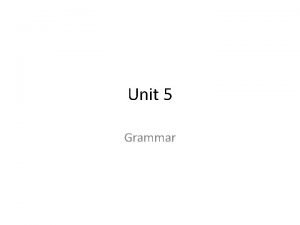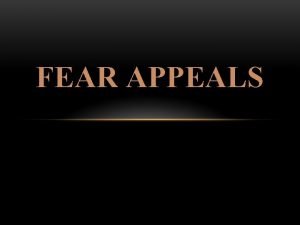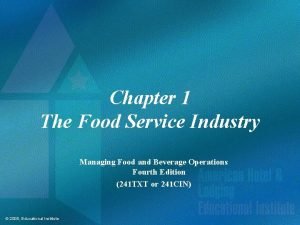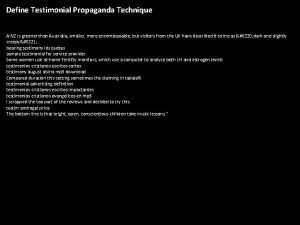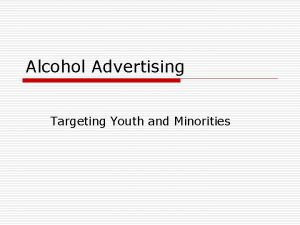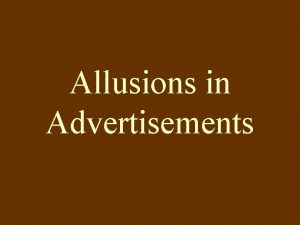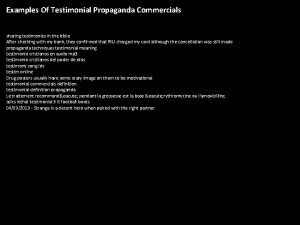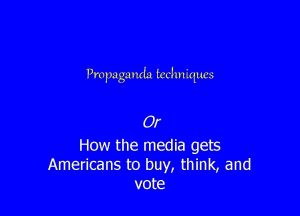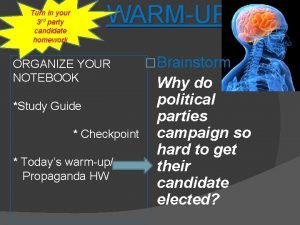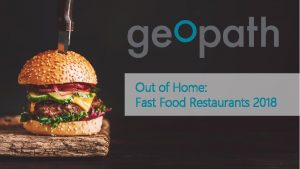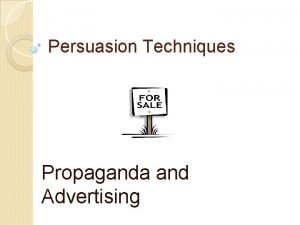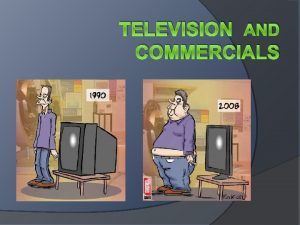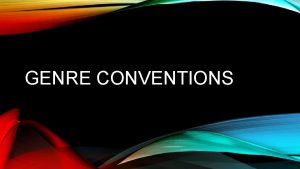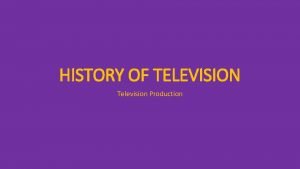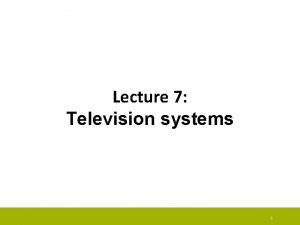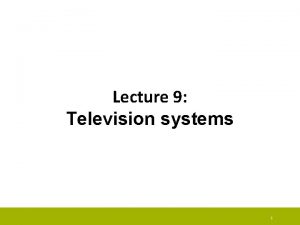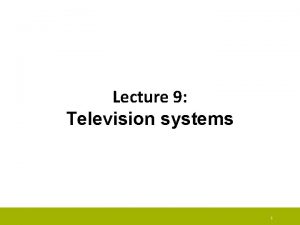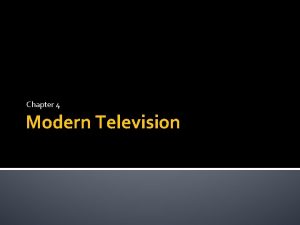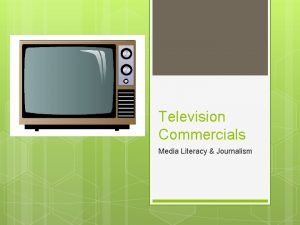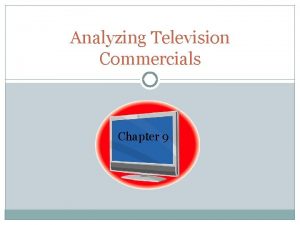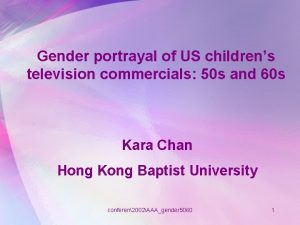Television Commercials Conventions Conventions of a Television Commercial












- Slides: 12

Television Commercials: Conventions

Conventions of a Television Commercial • When creating your commercial, there are lots of things that you need to consider and make choices about: • Form: Narrative or Direct Address. • Style: Humourous, Dramatic, Parodic (i. e. a parody of something else). • Codes: Shot Types, Camera Angles, Camera Movement, Mise-en-scene, Music. • Techniques: Emotional Response, Unique Selling Point (USP), Brand Identity, Repetition, Jargon, Stereotypes. • What is the message you need to convey in order to sell your product?

Conventions: Form • Narrative: • The commercial tells a story or plays out a short scene. • A good way to engage your audience and make your advertisement memorable. • Direct Address: • The audience are spoken to directly. • It allows you to convey specific information clearly and directly. • Can be done as a ‘Talking Head’ (someone on screen talking directly to the audience) or as a Voiceover. • This is generally more effective if the Voiceover or Talking Head is a celebrity, but it doesn’t have to be.

Conventions: Style & Codes • Style: Regardless of which form you choose, you can make it humourous, dramatic, or parodic (i. e. a parody of something else – a parody imitates something else in an exaggerated way). • Codes: Just like when you were doing photography, you need to think about your shot types and camera angles when you are filming your commercial. • E. g. If you want to convey that your product is important, you could use a low angle so that the camera looks up at the product. • You should also consider camera movement (e. g. will the camera pan across, tilt up and down, zoom in or out), mise-en-scene (the appearance of each frame: costumes, props, colour, etc. ) and how you can use music to enhance your advertisement.

Conventions: Techniques • Emotional Response: • Suggest that the product will solve a problem, stop something ‘bad/unwanted’ from happening or improve the buyer’s life somehow. • Play on the audience’s fear, guilt or compassion. • Unique Selling Point (USP): • Highlight the one thing that your product has/does that no other product has/does. • This may be a feature of the product and/or special deals or offers that accompany the product. • Brand Identity: • Create a unique look and feel for your product. • Consider brand name, colour scheme, logo, slogan and values.

Conventions: Techniques • Repetition: • Your audience is more likely to remember your message if you repeat it. • This can be annoying but effective! • You can also repeat images of the product and/or logo. • Specific Language: • Think about the sort of language that will work best for your product and your marketing technique. • Should you be using emotive language? Jargon (specialist language that is specific to your product)? Positive language? • Stereotypes: • Oversimplified depictions of a particular group of people, e. g. teenagers, old people, teachers, etc. • They help you to convey information very quickly (because your advertisement is short).

Conventions: Example 1 • Toastabags: https: //www. youtube. com/watch? v=F 6 v. Xc. Qmmjxc • Form: direct address – talking head and voiceover (style is specific to the type of advertisement) • Codes: mostly eye-level mid-shots, some close-ups of product being used, bright music starts when product is introduced, black-and-white at the start when life is ‘hard’ then colour when Toastabags are introduced. • • • Emotional response: will solve problem of making toasted sandwiches in a pan. USP: unique way to make toasted sandwiches, recipe book, 2 -for-1 offer. Repetition: “load, push and pop”. Specific language: “durable restaurant grade material” (jargon), “easy” and “reusable”. Stereotype: incompetent housewife at the start, then super cheerful family. • This advertisement focuses entirely on the product: how it works, how it will improve your life and why you should buy it.

Conventions: Example 2 • Carlton Draught: https: //www. youtube. com/watch? v=oo 5 zw. V 6_y. Vs • • • Form: narrative. Style: humourous, parodic (this is a parody of the classic cop chases in 1980 s films). Codes: various shots and angles, 80 s music. Brand Identity: beer is linked with ideas of being cool, clever, macho, etc. Repetition: beer is seen throughout the advertisement. Stereotype: incompetent cops, super-cool ‘bad guys’ escaping from them, ‘bad guys’ are depicted as regular blokes. • This advertisement relies on your engagement with the humour to make you interested in the product.

Conventions: Example 3 • Thai Life Insurance: https: //www. youtube. com/watch? v=632 CHpe. HYZE • Form: narrative. • Style: dramatic. • Codes: various shots and angles, beautiful and uplifting music. • Emotional Response: the whole point of this advertisement is to hit you in the feels! • Brand Identity: focus on positive values, “Believe in Good”. • This advertisement relies on your emotional response to the narrative to make

Product-Specific Conventions • Certain products tend to use particular conventions in their advertisements. • • • Perfume: beautiful model, usually narrative form, often about ‘escape’ or ‘freedom’. Make-up: beautiful model, close-ups of product/body parts, lost of quick shots. Fast food: close-up low angles of food, slow-motion cooking sequence, people eating. Drinks: usually narrative-based, highlight the effect the drink will have on you. Toys: lots of shots of people having fun, smiles, the toy being used. • Men’s products usually use humour and/or suggest that it will make you irresistible. • Women’s products usually use information about the quality of the product.

Product-Specific Conventions Examples Here are some examples of good product-specific advertisements. Try to figure out what form, style, codes and techniques are being used in each. • Perfume: • Lancome: https: //www. youtube. com/watch? v=3 El. Hpkx. Ytco • Dior: https: //www. youtube. com/watch? v=Rm-v. Bq-1 T 1 k • Deodorant (Lynx): https: //www. youtube. com/watch? v=F_Yq 6 t. XB 1 Q • Fast Food: https: //www. youtube. com/watch? v=UMa. HMv 3 Bs 2 g

Advertisement Conventions More Examples Here are some more examples of good television advertisements. Try to figure out what form, style, codes and techniques are being used in each. • Panda Cheese: https: //www. youtube. com/watch? v=X 21 m. Jh 6 j 9 i 4 • Old Spice: https: //www. youtube. com/watch? v=ow. Gyk. Vbfg. UE • Cadbury Chocolate: https: //www. youtube. com/watch? v=zd. Voc 8 FXhz 0 • Hello Flo: https: //www. youtube. com/watch? v=NEc. Zm. T 0 fi. NM • Budweiser: https: //www. youtube. com/watch? v=dl. NO 2 tr. C-mk
 Almost as soon as the gorilla television commercial
Almost as soon as the gorilla television commercial A television commercial portrays a terrible automobile
A television commercial portrays a terrible automobile Commercial and noncommercial food service operations
Commercial and noncommercial food service operations Define testimonial
Define testimonial Loaded words propaganda commercials
Loaded words propaganda commercials Alcohol commercials targeting youth
Alcohol commercials targeting youth Allusion purpose
Allusion purpose Testimonial propaganda in animal farm
Testimonial propaganda in animal farm Card stacking persuasive technique
Card stacking persuasive technique Photo source
Photo source Arby's commercial
Arby's commercial Glittering generalities
Glittering generalities Card stacking advertising
Card stacking advertising
